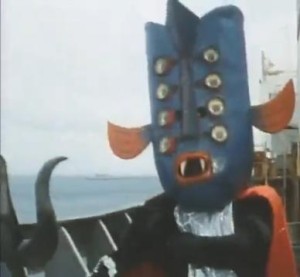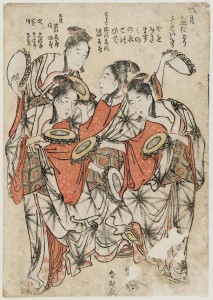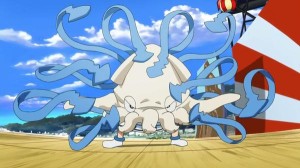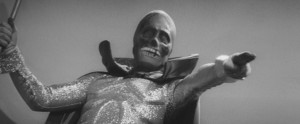Bon Odori Returns
by RadiumEyes, HSM team writer
Every year for the past five centuries or so, Japan celebrates the solemn festival known as Bon-Odori, a tribute to the souls of one’s ancestors. Traditionally held on the seventh month of the lunar calendar, Bon Odori today usually takes place in August or September; the great yagura at the center of the festivities marks the focal point, as people dance around it to the sound of the taiko drum. The festival culminates in the placing of lit lanterns in a river (an event known as Toro Nagashi), each one signifying a specific soul, with fireworks accompanying them; these lanterns help guide spirits to the afterlife, so that they may not get lost along the way.
Once upon a time, the Bon Odori had its own public space on Home; however, with that space now gone, the festival now must find a new area to set up shop. This year, the Great Edo of Nippon hosts the illustrious event, where visitors can go behind the onsen to see the conviviality of the festival underway. The world becomes a festival of lights, with lanterns bedecking all the stalls and the yagura itself to commemorate both ancestors and the recently deceased. Everything about it is specially geared toward honoring the dead – the dance welcomes the spirits of the dead, accompanied by min’yo songs sung by participants. One can hear the upbeat refrains of one such song upon entering the space; you’re now immersed in the festival, presenting a welcoming aura to anyone who wishes to participate.
When you enter the festival grounds, you are greeted by the giant stage, which towers over the proceedings; a brief circling shot of the yagura takes place before you can officially interact with anything. Once you have control of your avatar again, you are free to explore at your leisure. Some of the standbys from the Great Edo space remain, such as the blow dart game, but a few new additions exist, catering to the new atmosphere. For example, one can receive a free dance locomotion, the sort one could see performed during the festival in real life. As a side note, Bon Odori dances can vary, with each illustrating a specific aspect of society – each region has their own dances, with the Tanko Bushi (based on a mining folksong) and Dai Tokyo Ondo (a very popular dance for the festival) being prominent examples.
Outside of the dance, one can interact with the taiko at the top of the yagura; this taiko provides the beat for dancing. Technically speaking, the term taiko refers to all drums used in traditional Japanese music, with several categories describing the various drums available; the one present may be a nagado daiko, one of the more popular versions used by ensembles today. From there, various games are available to play; the dance circle allows you to perform a dance, while stands offering food give you free items, if you had not received them already in the Great Edo space. The “smart ball” game, a new addition to the festival, allows you to play a pachinko-style game for one Granzella ticket, where you shoot small balls into a board – the board contains various holes, each offering extra balls if you sink one into them. The value of each hole is indicated by the number beside it. At one point, a timer appears, and the values for the extra balls triples, so being careful and excellent with your timing will net you quite a few extra plays. When you conclude the game, you can trade in the total balls you’ve accumulated for souls.
 One can also obtain souls through the dart game, which now has a few new prizes available; aside from that, there’s also a stall which offers stuff for purchase – this includes fans, masks and kimonos. Note the rather prominent advertisement for the “U-Men,” a Power Rangers-inspired line of characters whose costumes you can purchase from the Granzella store proper. Granzella released a trailer illustrating the various unique motions available to them, as well as some other costumes that include an iPad-inspired one and the classic “black-costumed villain” that one might see in, say, an episode of Ika Musume (and yes, one episode actually includes a “hero show” as part of its premise). This part of Bon-Odori may have a precedent in Japanese history – the storytelling tradition of kamishibai (which originated in Buddhism) includes among its repertoire a modern tale known as Ōgon Bat, a figure with superhuman strength and invulnerability who protects the weak from the forces of Atlantis (you’d have to listen to the story to connect all this together.) This character had a 1966 live-action adaptation as well as an anime, which ran from 1 April 1967 to 23 March 1968.
One can also obtain souls through the dart game, which now has a few new prizes available; aside from that, there’s also a stall which offers stuff for purchase – this includes fans, masks and kimonos. Note the rather prominent advertisement for the “U-Men,” a Power Rangers-inspired line of characters whose costumes you can purchase from the Granzella store proper. Granzella released a trailer illustrating the various unique motions available to them, as well as some other costumes that include an iPad-inspired one and the classic “black-costumed villain” that one might see in, say, an episode of Ika Musume (and yes, one episode actually includes a “hero show” as part of its premise). This part of Bon-Odori may have a precedent in Japanese history – the storytelling tradition of kamishibai (which originated in Buddhism) includes among its repertoire a modern tale known as Ōgon Bat, a figure with superhuman strength and invulnerability who protects the weak from the forces of Atlantis (you’d have to listen to the story to connect all this together.) This character had a 1966 live-action adaptation as well as an anime, which ran from 1 April 1967 to 23 March 1968.
The hero show seen in an episode of Ika Musume is a stage show performed at the beach; such events occur in real life, with modern stage shows offering adaptations of popular manga/anime licenses such as Kamen Rider and various sentai programs. The U-Men carry on this wonderful tradition by offering costumes directly reflecting classic sentai teams as well as the typical enemies they fought on a weekly basis. If you grew up watching shows like J.A.K.Q. and Goranger, these costumes will bring back good memories of the shows that made the rounds from the 1970s onward; these shows had their own campy charm to them, and one cannot fault them for doing what they do best — offering exhilarating fights between the heroic sentai team and their monstrous antagonist.
Of course, the most direct comparison would be the Power Rangers, based on the long-running Super Sentai franchise that began in the 1970s. The Granzella trailer highlighting the U-Men is a loving reference to shows of the 1970s, where such teams were quite popular – Gorenger (1975) shows the classic formula of a five-man team combating the Black Cross Army, which plans to (what else?) conquer the world. One can look at the Black Cross Army and its minions to see the formula in action; each monster has a mask-based identity, ranging from Bronze Mask to Samurai Mask to Razor Mask. It even has one known as the “8-Eyed Mask,” which brings to mind the two-eyed villain clad in black available from Granzella.
Seeing all this in action is very exciting, as it’s all part of the good fun that comes with a festival, even one so solemn as the Bon Odori. It’s a moment of both celebration and reflection – as you enjoy a good game and purchase such things as kimonos, fans and masks, you can also pay respects to your ancestors and spend some quality time thinking of the road ahead. The beautiful lights and the night sky complement the scene wonderfully, and one gets a sense of the ethereal while here – life may be transient (images of the “floating world” come to mind), but there are many things to be thankful for. You can rest assured that your ancestors have lights to guide them down the river toward the afterlife, and they are at peace; through respecting one’s ancestors, life is reaffirmed.
Share
| Tweet |





 Twitter
Twitter
After reading this article, I instantly went on over to Great Edo to appreciate this event a lot more than I could. I like culture (I’m more into the Chinese culture than Japan)and you’ve simply showcased a very--VERY--unique perspective on what Bon Odoti really is. Such nostalgia came when I first ever stepped foot into the IREM Square and was culture-shocked on the items available.
Even the music is actually the vocal variant to the old IREM Square theme song.
This was a fantastic read, RadiumEyes.
Wonderful article RadiumEyes,
I enjoyed this festival recreation this year, I missed it last year because i wasn’t on home at the time. The lighting of the lanterns is a beautiful sight to see in the real world. It would be great if we could do that on Home.